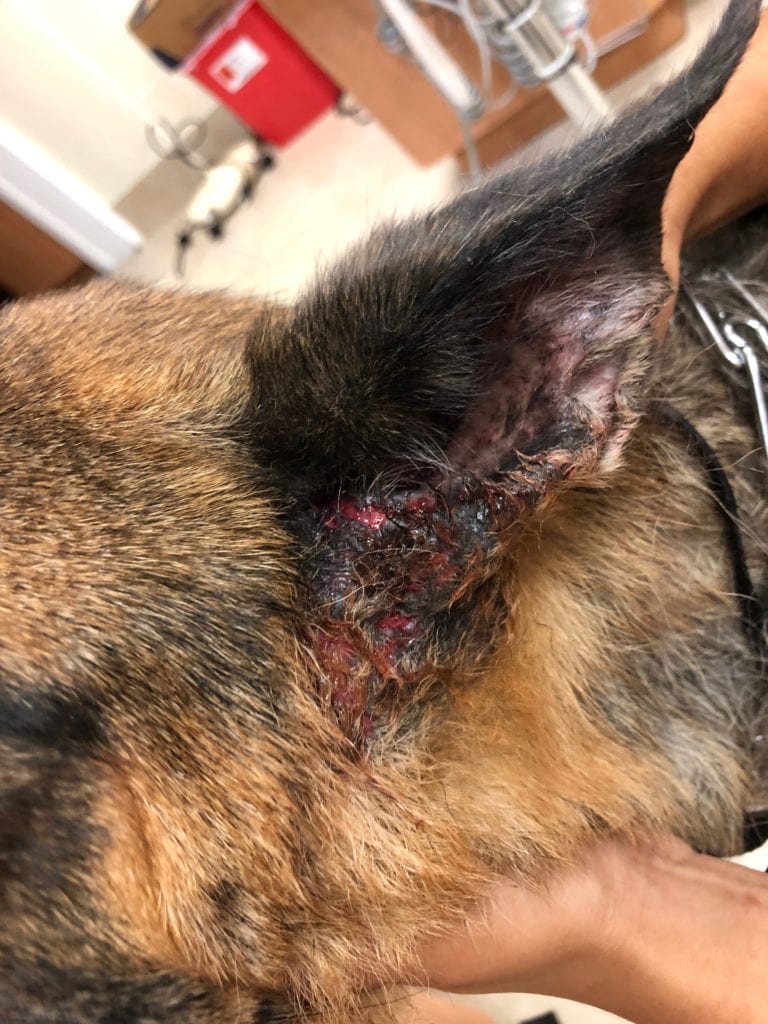Dr. William Oldenhoff
MVS Veterinary Dermatologist
If you’re reading this, chances are that at some point you have had a dog with an ear infection. Otitis (ear inflammation) is one of the most common reasons that pet owners bring their dog to the veterinarian. A significant amount of myth and misinformation has developed around ear disease. In this discussion, we will first start with the basics of ear disease, and then discuss some of the misconceptions about otitis.
The most common symptoms of otitis are scratching the ears, head shaking and smelly discharge in the ear canal. If your dog exhibits any of these signs, you should schedule an appointment with your veterinarian. Your vet will be able to diagnose an ear infection by examining the ears and sampling the debris in the ear canal. Ear infections can be very painful, so sometimes your vet may recommend sedation or anesthesia to perform a thorough examination of the ear canals. It is important to consult your veterinarian before putting anything in your pet’s ears!

Dogs usually develop ear infections due to yeast or bacteria. These microorganisms live in the ears and on the skin of mammals and normally do not cause problems. A normal ear canal is actually very resistant to infection, so something has to ‘go wrong’ for infection to develop. Rather than listing all of the different conditions that can lead to otitis, we will discuss acute (‘one time’) otitis and chronic (ongoing or recurring) otitis.
Acute otitis is the most common form of otitis. Dogs with acute otitis will typically respond well to a medicated ear drop from your veterinarian and the infection will not recur. Dogs with floppy ears or dogs who swim frequently may be more likely to develop these simple infections. Often there is not an ongoing disease predisposing them to recurring infection.
Dogs with chronic otitis are the dogs where the ear infection returns a few weeks or months after initially treating it. Your vet will often first treat these dogs the same as dogs with acute otitis. The biggest difference is that further investigation needs to be done regarding the underlying cause of ear infection. The most common causes of chronic otitis are allergies, hormonal abnormalities, excess oil production and disorders of skin formation (seborrhea). Dog with chronic otitis require a short term plan and a long term plan; the short term plan involves eliminating the infection that is present, and the long term plan involves preventive maintenance to ensure that infection does not recur. Again, always discuss these treatments with your veterinarian. Your veterinarian may recommend a referral to a veterinary dermatologist who specialists in skin and ear disorders.
When ear infections are allowed to continue without treatment, changes can occur to the ear canal including narrowing of the canal, scarring and even bone formation (calcification). Many of these changes are irreversible and may require surgery to correct. Thus, for dogs with chronic otitis it is vital to be proactive and prevent infections before the develop!
Now that we’ve covered some of the basics, let’s discuss some of the common questions about ear disease in dogs.
How often should I clean my dog’s ears, and with what ear cleaner?
The simplest answer is that you should clean your dog’s ears as often as they need it! For most normal dogs, only occasional ear cleaning is needed. As discussed above, dogs with chronic otitis often need frequent ear cleanings to prevent infection even their ears are doing well. These dogs often require specific medicated cleansers to prevent infection. As always, your vet is the best resource to recommend ear cleaners for your pet. Dog owners should not use rubbing alcohol, hydrogen peroxide or essential oils in their pet’s ears as these can be highly irritating to the ear canal lining.
Does swimming cause ear infections?
Although swimming can contribute to a dog developing an ear infection, there must be other abnormalities present to allow infection to develop. Studies have been done where pure bacterial culture was literally poured into the ear canals of normal dogs. These normal dogs did not develop ear infections! Thus, if your dog develops otitis after swimming, you should discuss underlying causes and treatment options with your veterinarian.
How often should I have my dog’s hairs plucked out?
Some dogs have a large amount of hair in their ear canals that can trap debris and moisture, leading to ear infection. This is especially common in poodles and poodle mixes (Labradoodles, Goldendoodles, etc) In these dogs, plucking is very important to prevent ear infection. Frequency of plucking should be tailored to the individual pet, as some dogs have more hair than others. Plucking the hairs can sometimes cause irritation of the canal and can contribute to development of otitis. If you find that your pet’s ears seem painful after being groomed, have them examined by your veterinarian. Your vet may recommend cleaners or drops for you to use after having your dog’s ears plucked.
Can I feed my dog anything to prevent ear infections?
Some dogs will develop ear infections secondary to food allergies. Your veterinarian may recommend a special prescription diet to help determine if food allergies are contributing. Grain-free diets have recently become very popular and are often promoted as a cure for many common diseases of pets, including ear infections. Unfortunately, there is no evidence to support these claims. When dogs become allergic to components of their food, it is almost always to a protein (most often beef, dairy or chicken) rather than grain. Additionally, food allergies cannot be ruled out by switching from one store brand to another; save yourself some headache and discuss diets with your veterinarian.
If your pet suffers from chronic ear infections, discuss options with your veterinarian. Ear infections can be a significant cause of pain and can affect our relationship with our furry friends. Long-term success requires a strong commitment, but your dog will thank you!



